

31987R2658. Council Regulation (EEC) No 2658/87 of 23 July 1987 on the tariff and statistical nomenclature and on the Common Customs Tariff Official Journal L 256 , 07/09/1987 P. 0001 - 0675 Finnish special edition: Chapter 11 Volume 13 P. 0022 Swedish special edition: Chapter 11 Volume 13 P. 0022 I (Acts whose publication is obligatory) COUNCIL REGULATION (EEC) No 2658/87 of 23 July 1987 on the tariff and statistical nomenclature and on the Common Customs Tariff HAS ADOPTED THIS REGULATION : Article 1 1.
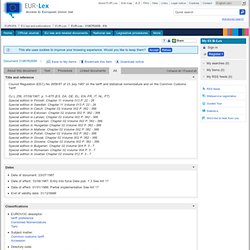
A goods nomenclature, hereinafter called the 'combined nomenclature', or in abbreviated form 'CN', is hereby established to meet, at one and the same time, the requirements both of the Common Customs Tariff and of the external trade statistics of the Community. 2. This Regulation shall be binding in its entirety and directly applicable in all Member States. Done at Brussels, 23 July 1987. Combined Nomenclature. TARIC code. Overview[edit] The TARIC code (Integrated Tariff of the European Communities) is designed to show the various rules applying to specific products when imported into the EU.
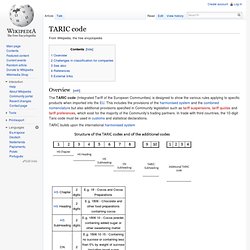
This includes the provisions of the harmonised system and the combined nomenclature but also additional provisions specified in Community legislation such as tariff suspensions, tariff quotas and tariff preferences, which exist for the majority of the Community’s trading partners. In trade with third countries, the 10-digit Taric code must be used in customs and statistical declarations. Harmonized System. The Harmonized Commodity Description and Coding System, also known as the Harmonized System (HS), of tariff nomenclature is an internationally standardized system of names and numbers for classifying traded products which came into effect in 1988, developed and maintained by the World Customs Organization (WCO) (formerly the Customs Co-operation Council), an independent intergovernmental organization with over 170 member countries based in Brussels, Belgium.
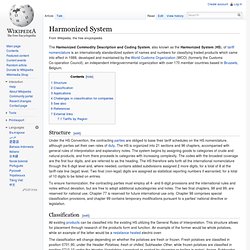
Structure[edit] To ensure harmonization, the contracting parties must employ all 4- and 6-digit provisions and the international rules and notes without deviation, but are free to adopt additional subcategories and notes. The two final chapters, 98 and 99, are reserved for national use. Chapter 77 is reserved for future international use only. Chapter 98 comprises special classification provisions, and chapter 99 contains temporary modifications pursuant to a parties' national directive or legislation. Classification[edit] Canada. World Customs Organization. Headquarters building The World Customs Organization (WCO) is an intergovernmental organization headquartered in Brussels, Belgium.
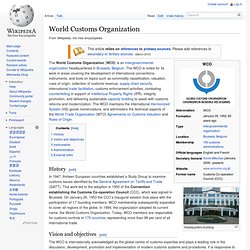
The WCO is noted for its work in areas covering the development of international conventions, instruments, and tools on topics such as commodity classification, valuation, rules of origin, collection of customs revenue, supply chain security, international trade facilitation, customs enforcement activities, combating counterfeiting in support of Intellectual Property Rights (IPR), integrity promotion, and delivering sustainable capacity building to assist with customs reforms and modernization. The new Incoterms® 2010 rules. Incoterms® 2010: Your essential tool to ensure correct application of the Incoterms® rules in global and domestic sales transactions Order a copy of Incoterms® 2010 now Incoterms® - International Commercial Terms The Incoterms® rules are an internationally recognized standard and are used worldwide in international and domestic contracts for the sale of goods.
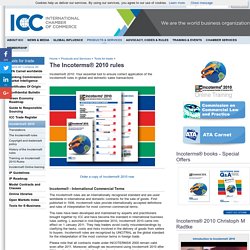
First published in 1936, Incoterms® rules provide internationally accepted definitions and rules of interpretation for most common commercial terms. Rules of origin. Rules of origin are used to determine the country of origin of a product for purposes of international trade.
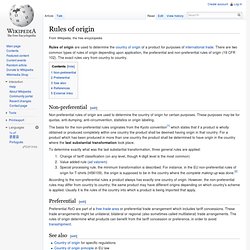
There are two common types of rules of origin depending upon application, the preferential and non-preferential rules of origin (19 CFR 102). The exact rules vary from country to country. Non-preferential[edit] Non-preferential rules of origin are used to determine the country of origin for certain purposes. These purposes may be for quotas, anti-dumping, anti-circumvention, statistics or origin labeling. The basis for the non-preferential rules originates from the Kyoto convention[1] which states that if a product is wholly obtained or produced completely within one country the product shall be deemed having origin in that country. To determine exactly what was the last substantial transformation, three general rules are applied: Incoterms. The Incoterms rules or International Commercial Terms are a series of pre-defined commercial terms published by the International Chamber of Commerce (ICC) that are widely used in International commercial transactions or procurement processes.
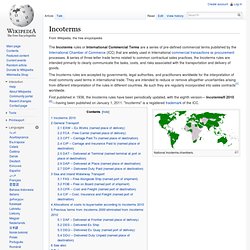
A series of three-letter trade terms related to common contractual sales practices, the Incoterms rules are intended primarily to clearly communicate the tasks, costs, and risks associated with the transportation and delivery of goods. The Incoterms rules are accepted by governments, legal authorities, and practitioners worldwide for the interpretation of most commonly used terms in international trade. They are intended to reduce or remove altogether uncertainties arising from different interpretation of the rules in different countries. As such they are regularly incorporated into sales contracts[1] worldwide. National Incoterms chambers. Incoterms 2010[edit] General Transport[edit] EXW – Ex Works (named place of delivery)[edit] See also[edit]